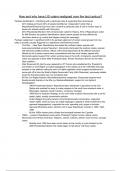How and why have US voters realigned over the last century?
Partisan identification = identifying with a particular party & supporting their aims/values
- 2014 Gallup poll found 42% of people identified as ‘independent’ rather than a
Republican/Democrat (but most ‘lean’ towards a particular party & vote in similar ways to
those who actually identify with that party)
- 2012 Presidential Election: 92% of Democrats voted for Obama, 93% of Republicans voted
for Mitt Romeny (so partisan identification clearly means people are less affected by
short-term factors e.g. events that happen during the campaign)
Partisan realignment = significant shift in the partisan alignment of certain social groups from one
party to another (usually triggered by a significant crisis/historical event)
- Civil War → New Deal: Republicans dominated the northern states, popular with
businessmen/skilled workers/’freedmen’, Democrats dominated the southern states, popular
with farmers/unskilled workers; effects of the Great Depression & the different solutions
offered by the 2 parties meant many reconsidered who they most closely aligned with:
Democrats gained support from urban working class in the north, immigrants, Jewish/Catholic
voters (as opposed to their white Protestant base), African Americans (known as the ‘New
Deal coalition’)
- After Roosevelt (D) died he was replaced by VP Truman who established the ‘President’s
Committee on Civil Rights’ & ended segregation in the military, & at the 1948 DNC the party
adopted a new platform calling for new civil rights legislation which angered southerners &
some split off to form the State’s Rights Democratic Party (AKA Dixiecrats); previously reliable
south (for the Democrats) was now somewhat split
- 60/70s Civil Rights/Vietnam War/welfare/abortion realignment: Democrats became more
fiscally/socially liberally in the 60s e.g. Medicare/Medicaid, support for civil rights &
desegregation
- 1964 Presidential Election: Republican Barry Goldwater’s opposition to the Civil
Rights acts enabled his party to make progress in the south (won electoral votes in
Mississippi, Alabama, South Carolina, Louisiana, Georgia)
- 1968 Nixon’s Southern Strategy: to win over white southern Democrats with a call for
states’ rights, socially conservative policies
- Under Reagan the party became more fiscally/socially conservative: supported
‘state’s rights’ (seen by many as coded language to appeal to white southerners who
opposed desegregation), supported tax cuts, spending cuts, prayer in schools,
opposed affirmative action, abortion; led to easy Republican victories in 1980, 1984,
1988
- By the 1980s clearer policy divides had emerged between the 2 parties
- 1980s → present: Republicans have white, Protestant, higher income, elderly voters;
Democrats have African American, Hispanic, Jewish, Catholic, atheist, lower income, younger
voters
- Results since 1992 have been much closer as the country is more divided; by the
2000 Presidential Election the media began to talk about ‘red’/’blue’ states
, How do race and religion influence voting behaviour in US
elections?
Race/ethnicity:
- White voters are overwhelmingly Republican voters
- In 2008 90% of the people who voted for John McCain were white, 89% of voters for
Mitt Romney in 2012
- African-American voters are overwhelmingly Democratic voters
- In 1996 97% of African American voters voted for Clinton, 90% for Al Gore (2000),
88% for John Kerry (2004), 95/93% for Obama (2008/2012)
- Hispanic/Latino voters have consistently voted Democrat since 1988 but not as overwhelming
as white/African-American voters (still a solid Republican bloc)
- Difficult to talk generally about the ideological/cultural preferences of this group as it
encompasses a wide range of identities e.g. Columbian-Americans,
Spanish-Americans, Cuban-Americans
- Polls in 2012 showed 77% of Hispanic voters felt unauthorised immigrants should be
given the chance to apply for legal status; this view is the strongest link between this
group & the Democrats as on other issues e.g. abortion they are more closely aligned
with Republicans but other polling from 2012 showed Hispanic voters were
concerned about the same issues as other ethnicities (economy, healthcare, budget
deficit, foreign policy) so they probably align with the Democrats on these as well
Religion:
- Jewish voters are very liberal compared to other groups e.g. 2012 polls found 93% believed
abortion should be legal in all/most cases, 81% supported gay marriage, 81% supported
higher taxes on incomes over $1m
- So generally support the Democrats in large numbers e.g. in 1996 90% of Jewish
voters voted for Clinton
- Republican Party is usually more outspoken in its support for Israel but a majority of
Jewish voters still favour Democratic fiscal/social policies
- Catholic vote is less predictable (has been since social issues arose in the 60s/70s) e.g.
George W. Bush won 52% of Catholic voters in 2004 even though John Kerry (D) was
Catholic
- In recent elections the Catholic vote has been almost completely evenly split
- Protestant voters: mainline Christians (Bible must be interpreted for current times & its
meaning can evolve) are more liberal, Evangelical Christians (Bible is the infallible word of
God; doesn’t need to be interpreted) are more conservative
- Late 70s saw the rise of the ‘religious right’ incl. the ‘Moral Majority’ (conservative
evangelical pressure group founded in 1979 by TV preacher Jerry Falwell) & this
helped Reagan win the 1980 Presidential Election (Republican Party Platform had
dropped support for an Equal Rights Amendment, added support for school prayer,
supported a right to life Amendment); since then the evangelical vote is much more
closely aligned with the Republicans




